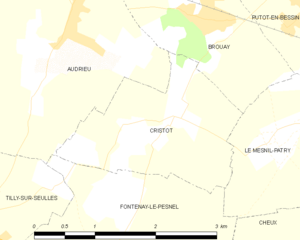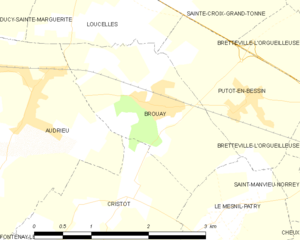Battle of Le Mesnil-Patry facts for kids
Quick facts for kids Battle of Le Mesnil-Patry |
|||||||
|---|---|---|---|---|---|---|---|
| Part of the Battle for Caen | |||||||
 Map of Le Mesnil-Patry and Cristot (commune FR insee code 14205.png) |
|||||||
|
|||||||
| Belligerents | |||||||
| Strength | |||||||
| The Queen's Own Rifles of Canada 1st Hussars |
12th SS Panzer Division | ||||||
| Casualties and losses | |||||||
| 116 dead or missing 35 wounded 22 captured 51 tanks |
189 3–14 Panzer IV |
||||||
The Battle of Le Mesnil-Patry was a tough fight during World War II. It happened in Normandy, France, in June 1944. This battle was the last big tank attack by Canadian troops in Normandy that month.
Canadian soldiers from The Queen's Own Rifles of Canada and the 1st Hussars attacked the village of Le Mesnil-Patry. Their goal was to move south towards higher ground. This attack was part of a bigger plan to capture the city of Caen. It also aimed to help other Allied divisions advance.
The battle ended with a German victory. However, the Germans did not achieve their main goal. They wanted to stop the Allied invasion, but they failed. After this battle, both sides changed their fighting methods. The Germans built stronger defenses. They saved their tanks for smaller counter-attacks. The Allies started gathering more supplies for bigger, slower attacks.
Sadly, some German soldiers from the 12th SS-Panzer Division treated Canadian prisoners very badly. This led to a Canadian commander ordering his troops not to take German prisoners. But this order was quickly stopped by higher-ranking officers. After this, Canadian attacks in this area mostly stopped. Only small patrols continued until a new big operation began later in June.
Contents
What Happened Before the Battle?
The D-Day Invasion
On June 6, 1944, Allied forces launched a huge invasion of France. This event is known as D-Day. Thousands of ships carried soldiers to the beaches of Normandy. About 3,000 aircraft supported them from the sky.
The D-Day landings were successful. But the Allies could not capture Caen as they had planned. American and British paratroopers jumped behind German lines. Their job was to capture bridges and silence German guns. This would make it harder for the Germans to fight back.
The Allies created a strong area on the east side of the Orne River. This area protected the beaches where troops landed. It also forced the Germans to use their valuable tanks there. This position was important for future attacks towards Caen.
Planning the Attack
The Canadian Battle Plan
On June 9, Canadian soldiers moved to a new area called Bray. On June 10, they started planning a new attack. This attack aimed to close a gap between two Canadian brigades. It would happen in the Mue river valley.
The plan was for Canadian tanks to advance south. They would capture high ground beyond Cheux. This was to support a bigger attack planned for June 12. However, on June 11, the smaller attack was combined with the main one. It became part of a new effort to capture high ground south of Cristot.
Another British division attacked further west. This was to keep German units busy. It would stop them from moving to help other German forces. If the Canadian attack worked, a German tank unit would be cut off. This would create a weakness in the German defenses. It could open the way to Caen.
The Canadian 1st Hussars tank unit got their orders on the morning of June 11. They had very little time to prepare. The commander could not scout the area properly. He also could not give detailed orders to his troops. Many soldiers did not know the full plan. Some thought it would be a simple artillery exercise.
The attack was supposed to start from Canadian positions in Norrey. The 1st Hussars and the Queen's Own Rifles would advance two miles south. They would capture high ground near Cheux. The infantry soldiers would ride on the tanks. Their first goal was to reach Le Mesnil-Patry by 1:00 p.m. Then they would move around the village to bypass Cheux. The commanders asked for more time to get ready. But their request was denied. The success of other British attacks depended on this quick action.
A Canadian success would force the Germans out of Cristot. This would help the British advance. It would also cut off a part of the German 12th SS-Panzer Division. This could open a path to the Odon River. Or it could allow the Canadians to move east towards Carpiquet. This would surround the rest of the German division. If the 1st Hussars took Le Mesnil-Patry, other Canadian tank units could attack south. This would make Caen very difficult for the Germans to hold.
The Battle Begins
Fighting at Le Mesnil-Patry
The 1st Hussars had just received new tanks and crews. These new soldiers had not had much time to get used to their units. Few of them knew the battle plan well. The Canadian tanks moved south. They carried infantry soldiers on their backs.
The Canadian column reached Norrey-en-Bessin around 2:00 p.m. They found that the Canadian troops already there had not been told about the attack. Also, the planned starting point was in a minefield. The open fields towards Le Mesnil-Patry were empty. There was no sign of the Germans leaving.
The village of Le Mesnil-Patry had a church in the center. German soldiers were hiding inside the village. The Canadian advance had been reported to the Germans. As the lead tanks reached the village, German artillery and mortar fire began. The Canadian infantry on the tanks were in the open. The tanks sped up. But in the village center, the road turned sharply. At 3:06 p.m., the Canadians reported that they were stopped by hidden German fire.
German soldiers and tanks from the 12th SS-Panzer Division ambushed the Canadian tanks. They had learned about Canadian radio plans from a captured tank. The Germans had been told to let the tanks pass. Then they would attack the infantry following behind. But the Canadian infantry were riding on the tanks. So the Germans opened fire right away. The Canadian infantry jumped off the tanks. The tanks drove fast towards Le Mesnil, firing wildly. Fierce hand-to-hand fighting broke out between German and Canadian soldiers.
The Canadian Sherman tanks were easy targets in the narrow streets. They tried to reach open ground. The infantry were left to fight the Germans alone. The Canadian force was scattered. They had no safe base until the infantry could secure the village. Some infantry followed the tanks on foot. The tanks destroyed some machine-gun nests. But then hidden anti-tank guns hit six tanks. Other Canadian tanks tried to help. But they were accidentally fired on by British anti-tank gunners.
As the Canadian tanks and infantry advanced, they were attacked from all sides. They had broken through the German lines. German anti-tank guns and Panzer IV tanks supported the Germans. The German commander, Wilhelm Mohnke, asked for more tank support. Canadian infantry crawled forward to the edge of Le Mesnil-Patry. A small group of soldiers and two tanks entered the east end of the village.
Three German tanks attacked from the right. They destroyed several Canadian tanks hiding in an orchard. Both German and Canadian infantry took cover. Tanks on both sides were knocked out. A Canadian tank crew saw many German tanks and soldiers getting ready to attack. They saw about thirty tanks parked together. They also saw 88mm guns and half-tracks. The Canadian tank destroyed three half-tracks. Then it caught fire. The crew drove backward for 600 yards while their tank burned. German soldiers threw grenades. The crew fired back before escaping into a ditch.
A German tank company was waiting in ambush south of Le Mesnil-Patry. When they saw smoke from destroyed tanks, they attacked. They quickly knocked out several more Canadian Shermans. The German tanks moved through the woods. They attacked the Canadian tanks from the side and rear. The Canadian commander realized his tanks were surrounded. He ordered a retreat back to the starting line. The Canadian tanks in the village were trapped. They were almost completely destroyed by German anti-tank weapons. The Germans destroyed between 37 and 51 Canadian Sherman tanks. Only two tanks returned.
Another Canadian attack happened in the Mue valley. British Royal Marine Commandos led this attack. They captured several villages. In the evening, they entered Le Hamel and Rots. German soldiers and Panther tanks resisted strongly in Rots. More Canadian tanks and infantry were sent as help. The German resistance was finally broken early on June 12. That night, artillery fire decreased. Ambulances collected wounded soldiers from both sides. The Canadians claimed to have destroyed 14 Panther tanks. During the night, Canadian tanks and infantry gathered behind the front line. They were ready to stop any German counter-attack.
The Attack on Cristot
The British 69th Infantry Brigade attacked Cristot. This attack was planned very quickly. Not much was known about the area. It was thought there were only scattered German infantry. But it was suspected that Germans were hiding. They were waiting for the main attack to show themselves.
The British planned to attack with two infantry battalions and tanks. The attack started from Audrieu to the north-west. This was to protect the left side of the British forces. The attack began at 2:30 p.m. But German reconnaissance troops had arrived around Cristot earlier.
Around 5:00 p.m., the British tanks and infantry got separated. This happened while moving through thick hedgerows. The Germans let the British tanks pass. Then they quickly destroyed seven of nine tanks from behind. By 6:00 p.m., the British infantry attack was also stopped outside Cristot. More British soldiers were sent forward. They started pushing back the German defenders. But German infantry got behind the British. By 8:30 p.m., the British had advanced close to their goal. But they had many casualties. German tanks attacked across the British path. The British were ordered to retreat to avoid being surrounded.
What Was the Outcome?
Counting the Losses
The Canadian D Company of the Queen's Own Rifles had 96 casualties. Most of them were listed as missing. Overall, 80 men from the 6th Armoured Regiment and 99 men from the Queen's Own Rifles were lost that day.
In total, 148 Canadians and 189 Germans were killed or wounded. Three German tanks were destroyed. In Rots, Canadian soldiers buried 122 German soldiers. The British Royal Marine Commando lost 17 killed, 9 wounded, and 35 missing. The defense of Cristot cost the German reconnaissance battalion about 70 casualties. The British 6th Green Howards lost 250 soldiers.
A few days after the Canadian attack, a Canadian padre and a sergeant went to identify the dead. They recovered identity tags. Some reports claimed that over 2,400 German dead were found. But this number seems to be too high.



